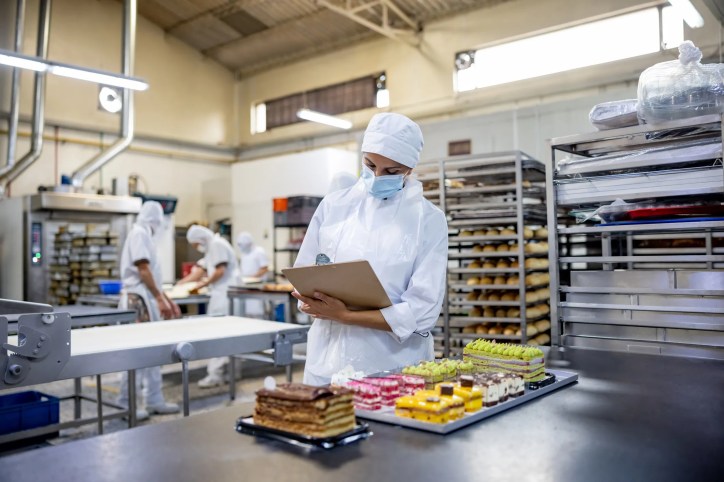The Centers for Disease Control and Prevention (CDC) found that 81% of investigated foodborne illness outbreaks were attributed to contamination of hands and surfaces, highlighting the importance of sanitation prerequisite programs (PRPs). Since a large portion of foodborne illness outbreaks occur due to the spread of germs from hands to food, assuring proper PRPs at food manufacturing locations is paramount for public health. ISO 22002-1:2025—Prerequisite programs on food safety – Part 1: Food manufacturing provides the specific details on how to implement and maintain PRPs within a food manufacturing setting.
What Are Prerequisite Programs (PRPs) for Food Safety?
Prerequisite programs (PRPs) are the basic conditions and activities that are necessary to maintain a hygienic environment throughout the food chain and are essential for producing safe food. They are essential for the success of a HACCP (Hazard Analysis and Critical Control Points) system. The goal of PRPs is to prevent contamination of food products from the environment (e.g., facilities, equipment, personnel), and to support the implementation of HACCP. Examples of PRPs include the following:
- Good Manufacturing Practices (GMPs): A set of guidelines related to personnel, plant and grounds, sanitary operations, equipment, warehousing, and more.
- Good Hygiene Practices (GHPs): Measures that focus on personal hygiene, sanitation, and maintaining a clean environment.
- Sanitation Standard Operating Procedures (SSOPs): Detailed, written instructions for maintaining sanitary conditions in a food processing facility.
- Supplier Control/Management: Process of strategically managing and overseeing relationships with suppliers to ensure they meet organizational needs, quality standards, and contractual obligations.
- Pest Control: Measures that aim to prevent and control pests.
- Cross-contamination prevention: Measures that prevent the spread of contaminants.
- Equipment Maintenance and Calibration: Procedures for ensuring equipment is functioning properly and accurately.
- Waste Management: Processes involved in the proper handling and disposal of waste to prevent contamination.
- Warehousing: Managing storage and handling of products in warehouses.
- Water Safety: Precautions for assuring the safety of water used in the production process.
- Rework: Managing the handling of reworked products.
- Allergen Control: Practices aims for managing the risk of cross-contamination with allergens.
- Training and Employee Hygiene: Educational and practical for ensuring personnel are properly trained and follow hygiene protocol.
By implementing robust PRPs, food businesses can create a solid foundation for food safety, minimizing risks and assuring the production of safe food. However, implementing PRPs measures consistently can be challenging, which is where ISO 22000-1:2025 becomes extremely handy.
What Is ISO 22000-1?
ISO 22000-1:2025 focuses on establishing prerequisite programs (PRPs) for food safety in the food manufacturing sector. It is applicable to organizations of all sizes (from small businesses to large corporations) involved in food manufacturing: the specific activities and processes involved in transforming raw materials into finished food products, within the broader food supply chain. The standard addresses key aspects food manufacturing, including construction and layout of buildings, premises and work environment, utilities, waste management, equipment suitability and maintenance, cross contamination prevention, cleaning and sanitizing, and much more. The aim of ISO 22000-1:2025 is to establish, implement, and maintain PRPs to control potential hazards within food manufacturing processes.
ISO 22000-1:2025 does not duplicate the requirements given in ISO 22000 and is intended to be used in conjunction with ISO 22000 and ISO 22002-100.
What Are the Key Changes in ISO 22002‑1:2025?
ISO 22000-1:2025 cancels and replaces ISO/TS 22002-1:2009, which has been technically revised. The first main change is that the requirements in ISO 22000-1:2025 are applicable to food manufacturing only. The second key change is that the common requirements for the food, feed, and packaging supply chain have been moved to new part of the series, ISO 22002-100, which is a requirement of ISO 22000-1:2025.
How Does ISO 22002-100 Differ from ISO 22002‑1?
While ISO 22002-100 and ISO 22002‑1 are both part of the ISO 22002 series, they both serve different purposes related to food safety management. ISO 22002‑1 focuses specifically on PRPs for food manufacturing; ISO 22002-100 provides the common PRP requirements that are applicable across all food chain categories.
ISO 22002-100 acts as a foundational, unified standard for PRPs in food safety—specifying the common requirements for establishing, implementing, and maintaining PRPs throughout the food, feed, and packaging supply chain to assist in controlling food safety hazards with a food safety management system. This standard aims to help simplify certification, boost operational efficiency, and assure preparedness for ISO 22000. ISO 22002-100 also consolidates the common PRP requirements that were previously spread across different sector-specific ISO 22002 standards [like ISO 22002-1 (PRPs for Food Manufacturing), ISO 22002-2 (PRPS for Catering), ISO 22002-4 (PRPs for Food Packaging Manufacturing), ISO 22002-5 (PRPs for Transport and Storage), etc.,].
ISO 22002-1 is intended to be used in conjunction with ISO 22002-100. This means that when implementing PRPs for food manufacturing, one would follow the general guidelines in ISO 22002-100 and then apply the specific requirements outlined in ISO 22002-1.
How Does ISO 22000 Differ From ISO 22002‑1?
ISO 22000 and ISO 22002-1 are related but distinct standards. ISO 22000 provides the overall framework for food safety management systems, while ISO 22002-1 specifically details the requirements for prerequisite programs (PRPs) in food manufacturing. Essentially, ISO 22002-1 is a technical specification that elaborates on one specific aspect of ISO 22000, focusing on the practical steps needed to control food safety hazards in manufacturing environments.
ISO 22000, and its updated companion ISO 22000-1:2025, are crucial for assuring food safety and quality throughout the global supply chain.
ISO 22002-1:2025—Prerequisite programs on food safety – Part 1: Food manufacturing is available on the ANSI Webstore as well as in the following Standards Packages:
